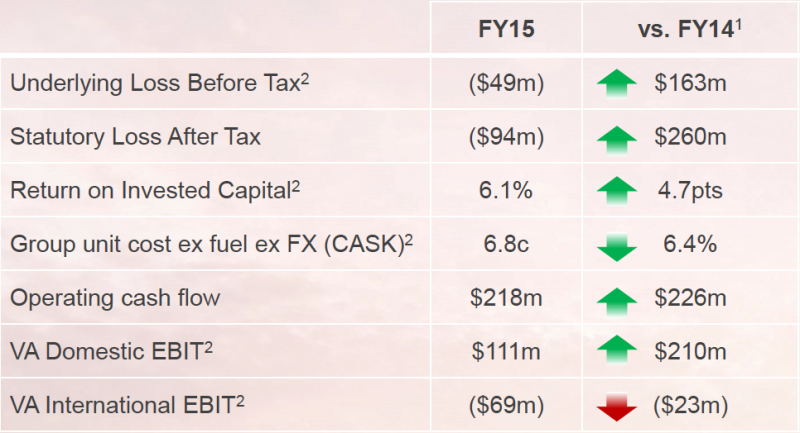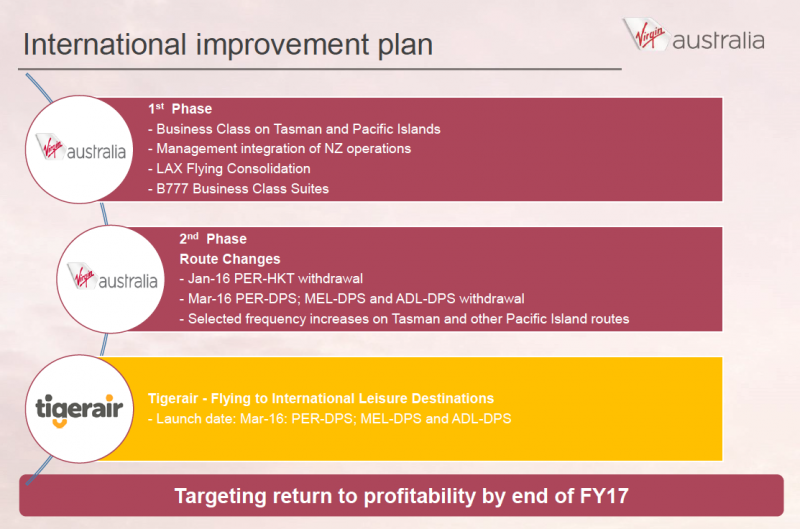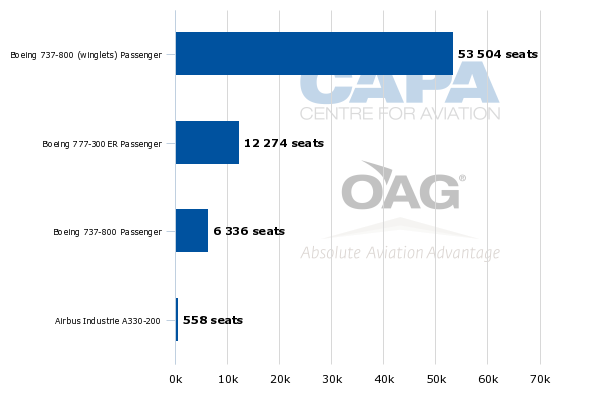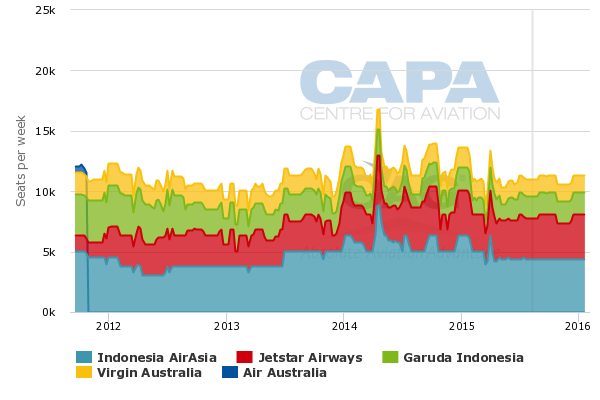Tigerair Australia goes international with 737-800s as Virgin Australia's group strategy evolves
Virgin Australia is adjusting its multi-brand strategy as it hands three of its Bali routes to Tigerair Australia. The changes should succeed at reducing the losses of Virgin's international operation but the group will ultimately need to make further strategic adjustments if it is to compete effectively in Bali and other medium haul leisure markets against Jetstar's 787s and Southeast Asia's other fast-expanding widebody LCC operators.
The new Bali routes will mark the launch of international services for the Tigerair Australia brand, which has only operated domestically since launching in 2007. The flights will however continue to be operated under the Virgin Australia air operators' certificate using Virgin Australia pilots, resulting in higher operating costs.
LCC competitors on Melbourne-Bali using widebody aircraft will also continue to enjoy much lower unit costs as Tigerair Australia is not able to configure the 737-800s to maximum density - or operate its own fleet of A320s - due to the length of the route. Tigerair Australia is taking over three Virgin Australia 737-800s, which will be retrofitted into 180-seat all economy configuration.
Virgin Australia Group is confident adjustments to its Southeast Asia network will drive further bottom line improvements
Virgin Australia announced on 7-Aug-2015 the transfer of the Melbourne-Bali, Adelaide-Bali and Perth-Bali routes to Tigerair Australia from 23-Mar-2016. The unveiling of plans to start using the Tigerair Australia brand in the international market coincided with the Virgin Australia's financial results briefing for the fiscal year ending 30-Jun-2015 (FY2015).
The changes in the Bali market are expected to help drive improvements to Virgin Australia's international operation as well as the group's overall profitability in FY2016 and FY2017.
The Virgin Australia Group incurred an operating loss of AUD49 million (USD41 million) in FY2015 compared to an operating loss of AUD212 million (USD195 million) in FY2014. Virgin Australia's international operation and Tigerair Australia remained unprofitable while the domestic operation swung to a profit with a positive EBIT contribution of AUD111 million (USD92 million) in FY2015 compared to an EBIT of negative AUD99 million (USD91 million) in FY2014.
Virgin Australia Group financial highlights: FY2015 vs FY2014
The EBIT contribution of Virgin Australia's international operation widened from a loss of AUD46 million (USD42million) in FY2014 to a loss of AUD69 million (USD57 million) in FY2015. But Virgin Australia is confident the international operation can narrow its loss in FY2016 and be profitable in FY2017, driving a return to profitability for the group by the end of FY2017.
The expected continued improvements to the group results will also be partially driven by the turnaround of Tigerair Australia, which narrowed its EBIT loss from AUD51 million (USD47 million) in FY2014 to only AUD9 million (USD7.5 million) in FY2015. The group expects Tigerair Australia to be profitable for the first time in its history in FY2016.
The transfer of the loss-making Melbourne-Bali, Adelaide-Bali and Perth-Bali routes to Tigerair Australia should help the group turn around its international operation. Virgin Australia is also dropping entirely a fourth unprofitable leisure route to Southeast Asia, Perth-Phuket, from 1-Feb-2016.
Other initiatives to improve the profitability of Virgin Australia's international operation include adding capacity in the New Zealand, Fiji and Solomon Island markets, where the group sees robust demand. The group also continues to make adjustments to its long haul operation, which consists of flights to Los Angeles and Abu Dhabi.
Virgin Australia international improvement plan
Virgin Australia operates its limited long haul network using a fleet of five 777-300ERs. The carrier's fleet of six A330-200s are now only used on domestic routes with the exception of one weekly frequency between Sydney and Nadi.
Virgin Australia uses 737-800s on all its routes to Southeast Asia, New Zealand and the South Pacific. (The only exception is Sydney-Nadi, which is served with seven weekly 737-800 frequencies and one weekly A330 frequency.)
Virgin Australia international seat capacity by aircraft type: 3-Aug-2015 to 9-Aug-2015
Virgin Australia to suspend services to Phuket
Virgin Australia currently serves 16 international destinations including its two long-haul destinations (Abu Dhabi and Los Angeles) and 12 destinations in New Zealand and the South Pacific. Bali and Phuket are Virgin Australia's only destinations in Southeast Asia.
Phuket is currently served with four weekly flights from Perth. Virgin Australia is the only carrier offering non-stop flights in the Perth-Phuket market but competes with LCCs offering highly competitive one-stop products including AirAsia/AirAsia X via Kuala Lumpur and Scoot/Tigerair via Singapore. Singapore Airlines/SilkAir also offers one-stop connections via Singapore and should benefit from Virgin Australia's withdrawal as Virgin Australia codeshares with Singapore Airlines on Perth-Singapore and SilkAir on Singapore-Phuket.
Virgin Australia CEO John Borghetti said at the 7-Aug-2015 results briefing that the group had concluded the Perth-Phuket market was not strong and big enough to maintain. Transferring Phuket to Tigerair Australia would likely not be an economical option as Perth-Phuket is about a six and half hour flight, making it even longer than Bali-Melbourne.
Virgin Australia will cut capacity to Bali by 50%
Bali is currently Virgin Australia's second largest international destination, accounting for slightly over 14,000 weekly seats. Auckland is the carrier's largest international destinations, accounting for about 16,200 weekly seats while New Zealand overall accounts for about 28,500 weekly seats.
Bali currently accounts for about 19% of Virgin Australia's total international seat capacity while Southeast Asia overall accounts for about 22%, according to CAPA and OAG data.
Virgin Australia international seat capacity by country: 3-Aug-2015 to 9-Aug-2015
Virgin Australia currently operates 40 weekly flights to Bali including 10 from Brisbane, nine from Sydney, eight from Perth, seven from Melbourne, five from Adelaide and one from Port Hedland (according to OAG schedules for the week commencing 3-Aug-2015). All flights are operated with two-class 176-seat 737-800s consisting of 168 seats in economy and eight seats in business.
All the Brisbane and Sydney frequencies and six of the seven Melbourne frequencies are operated during overnight hours on the return sector from Bali.
Virgin Australia capacity to Bali will be reduced by 50% after the last flights on the Adelaide, Perth and Melbourne routes are operated on 23-Mar-2016. Tigerair Australia will initially operate daily flights on Melbourne-Bali and Perth-Bali while Adelaide-Bali will be served with five weekly frequencies.
Tigerair Australia to configure 737-800s in 180-seat all-economy configuration
On a group level Virgin Australia capacity to Bali will be relatively flat as the three Tigerair Australia-branded 737-800s will have 180 seats compared to the 176 seats currently on these aircraft. The aircraft will be partially reconfigured with the 168 existing economy seats being reupholstered in Tigerair colours. The eight business class seats will be removed and 12 economy seats will be added, resulting in the new 180-seat single class configuration. Some galley space will also be removed.
The front three rows will offer extra legroom seats with about 35in of pitch, providing five rows or a total of 30 extra legroom seats when also including the two emergency rows. Tigerair Australia Rob Sharp told CAPA that the other 150 seats will have a pitch of about 31in to 32in. This will provide a slightly better product than the typical LCC seat pitch of about 30in. The Tigerair Australia 737-800s will also offer passengers wifi and wireless in-flight entertainment (a mix of free and paid), providing a better product compared to the carrier's A320s. The carrier also will offer an enhanced hot meal menu on its new international flights.
Tigerair Australia currently operates a fleet of 13 A320s in the typical LCC configuration of 180 all-economy seats with the two emergency rows being sold as extra legroom seats. The typical all-economy LCC configuration for 737-800s are 189 seats.
The decision to go with a less dense 180-seat configuration is sensible as Tigerair Australia would face payload limitations on Melbourne-Bali with a 189-seat aircraft. Tigerair Australia is also confident there is sufficient demand for a larger portion of extra legroom seats given the length of the route. Melbourne-Bali is nearly six hours while Adelaide-Bali is about five hours and Perth-Bali is slightly under four hours.
The shorter Adelaide-Bali and Perth-Bali routes could accommodate 189-seat 737-800s but Tigerair Australia wanted to avoid the complexities of two configurations for a small three-aircraft fleet. Adelaide-Bali and Perth-Bali could also be operated with Tigerair Australia's 180-seat A320s but the LCC needs the slightly longer range of the 737-800 to operate Melbourne-Bali.
Tigerair Australia would also need the range of the 737-800 to operate Sydney-Bali and Brisbane-Bali, although at least for now these routes will continue to be operated by Virgin Australia.
Melbourne-Bali could prove to be a challenging route with all-economy 737s
Melbourne-Bali could be viewed as a test case for Tigerair Australia as it is very unusual for a narrowbody LCC to operate a route of over five hours. If Melbourne-Bali is successful it could give the Virgin Australia Group the confidence to hand over similar medium haul routes such as Brisbane-Bali and Sydney-Bali.
If Tigerair Australia is able to turn profits on Melbourne-Bali and the two other Bali routes it also potentially gives the group the confidence to transfer 737-800s to the Tigerair Australia air operators' certificate (AOC). Mr Sharp said the initial three aircraft that will be repainted in Tigerair Australia colours and reconfigured will continue to fly under the Virgin Australia International AOC.
Virgin Australia pilots will be used but cabin crew will be provided by Tigerair Australia. Using Virgin pilots avoids Tigerair Australia having to retrain any of its pilots and the complexities of a twin fleet; but it also results in higher labour costs, which could potentially make the routes more challenging.
Turning a profit on Melbourne-Bali could be particularly challenging as Tigerair Australia will be competing against widebody LCC operators. Jetstar currently serves the Melbourne-Bali route nine times weekly with 787-8s while Indonesia AirAsia X operates five weekly flights using A330-300s. Jetstar has a 39% share of seat capacity in the Melbourne-Bali market followed by AirAsia X with a 25% share, Garuda with a 20% share and Virgin Australia with a 16% share.
Garuda Indonesia currently serves Melbourne-Bali daily with A330-300s. Once Tigerair Australia takes over from Virgin Australia, Garuda will be the only full service operator in the market. Eventually Garuda could look to hand over Melbourne-Bali and other Australia-Bali routes to its LCC subsidiary Citilink.
Melbourne to Bali capacity by carrier (one-way seats per week): 19-Sep-2011 to 24-Jan-2016
A330-300s offer significantly lower unit costs on routes of the five to six hour length of Melbourne-Bali than the 737-800s. New generation 787-8s are even more efficient, giving Jetstar lower unit costs than the A330-200s they replaced.
Mr Sharp told CAPA that Tigerair Australia expects to generate higher load factors than its LCC competitors as smaller gauge aircraft enable it to better match capacity with demand on a year-round basis. While the widebody LCC operators are likely to be profitable during the peak periods they have too much capacity during off peak periods, making it difficult to be profitable on a year-round basis. Tigerair Australia believes it could outperform its competitors on a year-round basis although will obviously not generate the profits the widebody operators can make during the peak travel days.
Tigerair Australia also believes its narrowbody product will be more appealing than a widebody LCC product offering less personal space. Mr Sharp also points out LCC widebody operators have lower aircraft utilisation rates and face higher risks than LCC narrowbody operators.
Bali-Melbourne is an unusually long route for a narrowbody LCC - with no connectivity
But ultimately it seems unlikely that Tigeair Australia will be able to generate sufficient yields to cover the relatively high cost of operating long narrowbody routes such as Melbourne-Bali.
Most narrowbody LCC routes of over five hours are operated in high yielding markets with limited competition and significant business demand. Bali is almost entirely a price sensitive leisure market and is also hugely competitive.
For example flydubai operates more routes of over five hours than any other airline in the global LCC sector, but these routes are in niche high yielding routes to Central Asia and Africa. flydubai and other narrowbody LCCs operating longer routes also rely on and benefit from feed. Mr Borghetti said Tigerair Australia will continue with its current strategy of not pursuing any codeshares including with Virgin Australia.
Tigerair Australia is offering promotional one-way fares starting at AUD89 (USD66) for Perth-Bali, AUD99 (USD73) for Adelaide-Bali and AUD129 (USD95) for Melbourne-Bali. Higher fares will likely be necessary to make these routes profitable - but Tigerair Australia could find it challenging to raise fares given the competition with other LCCs.
Prospects are brighter for Adelaide-Bali and Perth-Bali routes
Tigerair Australia could see better results on Adelaide-Bali and Perth-Bali as these are shorter routes with competition from narrowbody rather than widebody LCCs. Jetstar currently operates 19 weekly A320 flights on Perth-Bali and seven weekly A320 flights on Adelaide-Bali. Indonesia AirAsia operates 24 weekly A320 flights on the Perth-Bali route but does not compete in the Adelaide-Bali market.
Garuda Indonesia also operates one daily flight in the Perth-Bali market but uses A330-300s, giving it lower unit costs than the current Virgin Australia 737-800 operation.
Virgin Australia currently only has a 13% share of seat capacity between Perth and Bali compared to 16% for Garuda, 31% for Jetstar and 40% for AirAsia.
With the transfer of the route to its LCC subsidiary, the Virgin Australia Group is more likely to add capacity on Perth-Bali in future, enabling it to close the gap with its competitors.
Perth to Bali capacity by carrier (one-way seats per week): 19-Sep-2011 to 24-Jan-2016
In the much smaller Adelaide-Bali market, Virgin Australia currently has a 41% share of seat capacity compared to 59% for Jetstar, according to CAPA and OAG data.
Tigerair Australia will eventually need a new aircraft type for the Bali market
Brisbane-Bali and Sydney-Bali would provide similar challenges as Melbourne-Bali as Jetstar operates both routes with 787-8s. Indonesia AirAsia X is also planning to launch both routes as it expands its A330-300 fleet.
The Virgin Australia Group's most likely long-term solution for such routes would be A330s, 787s, A320neos or 737 MAX 8s operated by Tigerair Australia.
Tigerair Australia has begun reviewing its medium and long-term fleet options as part of an overall review at the Virgin Australia Group, which acquired an initial 60% stake in Virgin Australia from Singapore-based Tiger Airways Holdings in 2013 and the remaining 40% stake in 2014. Fleet options under review include Tigerair Australia taking over existing Virgin Australia aircraft or orders as well as placing new orders.
Virgin Australia has 32 737 MAX 8s on order, according to the CAPA Fleet Database. 737 MAX 8s or A320neos have more range and are significantly more efficient than current generation narrowbody aircraft, making longer routes such as Melbourne-Bali and Sydney-Bali more attractive.
Tigerair Australia needs to make a decision on renewing its existing narrowbody fleet while also deciding if it should take on widebody aircraft for Bali and potential other medium-haul markets. Alternatively it will need to decide if new generation narrowbody aircraft could be sufficient and compete effectively on six hour routes against A330-300s, 787s and future A330-300neos.
Tigerair Australia resumes growth as its turnaround is completed
Tigerair Australia has no more commitments to additional aircraft after it takes its 14th A320, which is slated to be delivered by the end of Aug-2015. This aircraft, Tigerair Australia's first additional A320 since FY2014, will be used to expand the carrier's domestic operation, including additional flights on Sydney-Adelaide and Sydney-Cairns from early Dec-2015.
Capacity will not immediately increase after the new aircraft is placed into service as the aircraft is needed for the next few months to backfill for aircraft coming up for heavy maintenance.
Over the last two years Tigerair Australia has taken a break from growth and been focussing on turning around its domestic operation. The domestic network was adjusted in 2014 as a new Brisbane base was opened and capacity was added to the Gold Coast while Alice Springs was dropped.
While taking over loss-making international routes from Virgin Australia has seemed like a sensible scenario since Virgin Australia acquired a majority stake in Tigerair Australia in 2013, the LCC previously stated it wanted to focus first first on domestic improvements.
As CAPA reported in Sep-2014:
Tigerair Australia will not add any capacity until the market is ready. The focus for now is still on improving unit revenues and turning around the airline rather than growth. Tigerair Australia does not believe it is a sensible strategy to add an aircraft unless there is a market to profitably deploy the aircraft.
There could be opportunities for Virgin Australia to transfer unprofitable narrowbody international routes to its LCC subsidiary as well as for Tigerair Australia to enter some new leisure focused international markets. But at least for now Tigerair Australia remains entirely committed to the domestic market.
See related report: Tigerair Australia to pause from growth - with possible A320 deferrals - as losses continue to mount
Tigerair Australia starts a new chapter with its international operation
Tigerair Australia has made significant improvements over the last year, narrowing its loss while improving its on time performance and customer satisfaction ratings. The brand seems to have finally recovered fully from the 2011 grounding.
Tigerair Australia financial highlights: FY2015 vs FY2014
Tigerair Australia is now on track to be profitable for the first time in its nearly 10 year history in FY2016. The sounder footing enables the LCC to resume domestic growth and finally start to pursue international expansion.
But it is unlikely the new international operation will be profitable in the initial phase.
The three Bali routes are more a strategic move that enables the Virgin Australia Group to maintain its presence in a key market while reducing the losses at its full-service international operation.
Handing the routes, along with three 737-800s, to Tigerair Australia will not be the last move the group makes as it tries to carve out a profitable niche in the highly competitive Australia-Southeast Asia market. It is a modest step towards evolving the group strategy, but a significant precedent as Tigerair shows its first international stripes.






